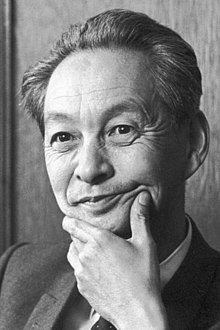Shin'ichirō Tomonaga
Shin'ichirō Tomonaga ( Japanese 朝 永 振 一郎 , Tomonaga Shin'ichirō ; born March 31, 1906 in Tokyo ; † July 8, 1979 ibid) was a Japanese physicist. He received in 1965 along with Richard P. Feynman and J. Schwinger the physics - Nobel Prize "for their fundamental performance in quantum electrodynamics , with deep implications for particle physics ."
life and work
Tomonaga was born in Tokyo in 1906. His family moved to Kyoto in 1913 , where his father, from whom a book on the philosophy of Immanuel Kant is known in Japan , had become a professor of philosophy.
Tomonaga graduated in 1929 with a close friend, Nobel Prize winner Hideki Yukawa , and then became an assistant to Yoshio Nishina (the developer of the Little Nishina formula ). Tomonaga adored his teacher all his life and even let himself be buried next to him. Under him he began to work on quantum electrodynamics .
During a research stay from 1937 to 1939 in Leipzig with Werner Heisenberg , Tomonaga continued his work and also began to deal with nuclear physics . After his return to Tokyo in 1939, he submitted a dissertation to the University of Tokyo, a work published in Germany on the “internal friction and thermal conductivity of nuclear matter” . In 1941 he became professor of physics at the Tokyo School of Humanities and Natural Sciences (later Tokyo University of Education , now Tsukuba University ).
Tomonaga worked on the meson theory of the nuclei ("intermediate coupling theory") and presented his own covariant formulation of quantum field theory as early as 1942 - significantly earlier than Julian Schwinger and Richard Feynman , with whom he shared the 1965 Nobel Prize in Physics.
Like Schwinger, Tomonaga engaged in radar research (waveguides, cavity resonators, magnetron theory) during the war . After the end of the war he continued his work on quantum electrodynamics and developed the renormalization theory independently of Schwinger.
In 1949 he was invited by Robert Oppenheimer to the Institute for Advanced Study in Princeton , where he dealt with quantum mechanical many-body theory and was the first to work on exactly solvable one-dimensional models of systems of charged fermions, the Tomonaga-Luttinger liquids , the nature of collective excitations in such Systems enlightened.
From 1955, Tomonaga set up the Institute for Nuclear Physics at the University of Tokyo . 1956–1962 he was both president of the Tokyo University of Education (now Tsukuba University) and director of the Japanese Science Council and otherwise an influential government advisor. From 1963 he was director of the optics institute at the university.
Tomonaga wrote a textbook on quantum mechanics in 1949, which was translated into English in 1963.
Tomonaga married in 1940 and had two sons and a daughter.
Awards and honors
In 1946 he received the Asahi Prize , the Japanese Academy Prize in 1948, the Japanese Order of Culture in 1952 , the Lomonosov Gold Medal in 1963 and the Osaragi Jirō Prize in 1980 for Butsurigaku to wa nan darō ka ( 物理学 と は 何 だ ろ う か ) . Since 1958 he was a corresponding member of the Bavarian Academy of Sciences . He was elected to the German Academy of Sciences Leopoldina in 1964, to the National Academy of Sciences in 1965 , and to the American Academy of Arts and Sciences in 1975 . In 1998 the asteroid (6919) Tomonaga was named after him.
Fonts
- Quantum Mechanics, 2 volumes, North Holland 1962, 1966
- The story of spin, University of Chicago Press 1997
literature
- Silvan S. Schweber: QED and the men who made it. Dyson, Feynman, Schwinger and Tomonaga . Princeton University Press, Princeton 1994, ISBN 0-691-03685-3
- Yoichiro Nambu and K. Nishijima: Activity of the Tomonaga group up to the time of the 1947 Shelter island conference . In: Nicola N. Khuri, Roman Jackiw , Steven Weinberg and Edward Witten (eds.): Proceedings Shelter Island II conference . MIT Press 1983
- Shin'ichirō Tomonaga: Welt im Spiegel , Ed. Erwin Müller-Hartmann , Steiner-Verlag, Stuttgart 1986, ISBN 3-515-04448-5
Web links
- Information from the Nobel Foundation on the award ceremony for Shinichiro Tomonaga in 1965 (English)
- Literature by and about Shin'ichirō Tomonaga in the catalog of the German National Library
- Conference in honor of Yukawa, Tomonaga
Individual evidence
- ↑ Tomonaga Progress of Theoretical Physics, Vol. 5, 1950, pp. 544-569
- ↑ Member entry by Sin-Itiro Tomonaga (with picture) at the German Academy of Natural Scientists Leopoldina , accessed on June 18, 2016.
- ↑ Minor Planet Circ. 32347
| personal data | |
|---|---|
| SURNAME | Tomonaga, Shin'ichirō |
| ALTERNATIVE NAMES | 朝 永 振 一郎 (Japanese) |
| BRIEF DESCRIPTION | Japanese physicist |
| DATE OF BIRTH | March 31, 1906 |
| PLACE OF BIRTH | Tokyo |
| DATE OF DEATH | July 8, 1979 |
| Place of death | Tokyo |
